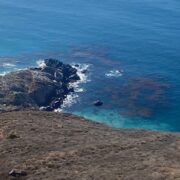Aravaipa Canyon Wilderness is one of the most lovely places I’ve ever had the pleasure of hiking. My trip in mid-November 2019 was made even better since I was able to enjoy it with two of my closest friends, each of whom live several states away. Hiking and backpacking the Aravaipa Canyon Wilderness requires permits from the Bureau of Land Management to prevent overuse and these can be reserved up to 90 days in advance through recreation.gov. The process was a bit clunky, as for a backpacking trip you need to reserve contiguous days and this wasn’t as intuitive as it has been for other “facilities” I’ve booked through recreation.gov. Kind of weird to think about wilderness as a “facility,” right?
Regardless, I was able to book the necessary permits as soon as they opened up and started looking forward to the trip in mid-August. Permits for the 12-mile canyon are limited to only 50 people per day — 20 from the harder-to-access east entrance and 30 from the more accessible west entrance. These limitations on use allowed myself and my companions to have a reasonably uncrowded experience, even on a weekend, which was quite a treat. Walking through a perennial stream in a desert environment is so blissful and sublime that it almost defies expression.
We stayed at the same campsite for the two nights we were in Aravaipa Canyon (the maximum allowed) and did a dayhike to a side canyon that had a quaint arch perched high up on its walls and some impressive sheer cliffs and narrow sections.
We had ideal weather, a nice campsite, and this trip was without a doubt one of my favorites. There’s also a nice short article by Edward Abbey about Aravaipa Canyon that can be found in his “Down the River” collection. I’m not an Abbey-acolyte by any means, but it’s always cool to read a well-done essay about a place you’ve visited. In fact, I’d consider it required reading for any visit to Aravaipa Canyon — it provides some history and insight that certainly made my trip more meaningful.








Home › Forums › Aravaipa Canyon Wilderness, Arizona